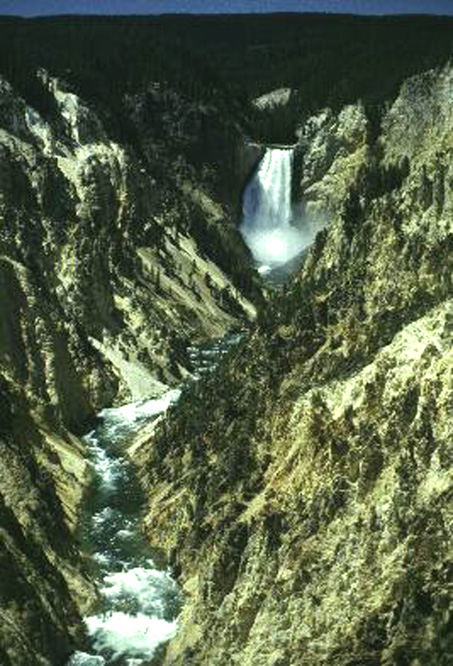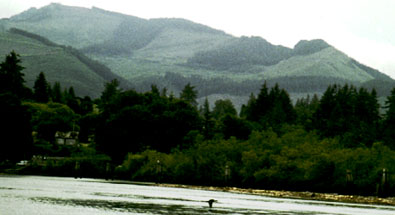 River
Conservation
River
ConservationNavigating the site:
Creating a more ecological future for the Columbia River Valley
Kai Lee, a critical assessment
Logging along the Columbia River Gorge looking north and east from Oregon to Washington state.
Ecolacy: a dialectic
The challenges of technology and necessity of human dignity.Conceptualizing the conflict over competing resource uses:
Columbia River watershed, "large ecosystems:"
Lee's organizational schema,Adaptiveness & Urban Planning Myths
The human dimensions in ecological situations
Design suggestions
"O" for organize your
thoughts.
Ecolacy: is a dialectic of how to live ecologically well.
Consistent, compatible, and complementary uses have both literate and numerate explanations that must be considered.
But from an ecological perspective on how to live well, what sort of evidence can be used to answer the question "and then what?"

Great falls on the Yellowstone River; Grand Canyon of
the Yellowstone.
What is it we value in nature: scenic monumentality or a place for other life?
Criteria Table 1:
| criteria |
numerate
|
literate
|
| consistent | ||
| compatible | ||
| complementary |
The challenges of technology and necessity of human dignity.
Technology has the ability to catalyze changes, or to speed-up and bring about impacts at an ever increasing rate of speed, to which human's -- or so McHarg and Van der Ryn argue -- are more or less unreliable in their responses to technological affects.
Consider the affects of automotive
transportation, supertankers, electricity, or even fire on human behavior.
Compare that to the impacts of these techniques on natural conditions.
Problem Solving Table 2:
| Dimensions | criteria |
numerate
|
literate
|
| Physical | ||
| Biological | ||
| Social |
Are large dams on
rivers and example of technological catalysts?
Columbia River watershed
is a drainage basin that extends into Canada and five states in the Pacific
Northwest.
How has the Columbia River come to symbolize the conflict between economics and ecology?
- Physical, basin for drainage arial sizes, elevations, climate.
- Biological, biogeographical provinces habitat, species, genetic diversity.
- Social, urban, rural and wild population, women's status.
What is the reason for needing to discover a more sustainable use of the Columbia River?
What are the economic benefits derived from the river and the watershed?Describe the ecological value and biologiocal wealth of the Columbia River basin and the ecosystem services derived from these natural assets of the watershed:
Consider several examples of each from the readings with respect to the Columbia River and the mountain ranges that give rise to this vast tibutary system:
Conceptualizing the conflict over competing resource uses:
| dimensions | features | The resources | description | sources |
| Physical, | the river: | |||
| Biological, | the fisheries & wildlife: | |||
| Social, | the people, cities, industries: | |||
| ecolate | and then what? |
Lee. pp. 18-50.
Columbia
River watershed, "large ecosystems:" multi-jurisdictional, international.
Kai Lee's organizational schema, his approach to the basin's ecological problems.
1. learning from the past
2. correcting errors
3. understanding and applying adaptive management
4. participating in bounded conflict
5. devising action plans and assessing the expected outcomes.There are numerous dams on the Columbia and Snake Rivers regulating the flow of water and blocking the migration of wild salmon, once a common upstream fishery in Oregon, Washington and British Columbia.
Contrasting
Lee's with McHarg's language.
| New terms: |
old
terms:
|
|
Adaptive
management
|
|
|
+
Bounded conflict
|
|
|
Social
Learning
|
|
Adaptiveness & Urban Planning Myths
What does it mean
to be adaptive biologically and ecologically?
Table for assessing ways to solve ecological problems:
| Dimensions | criteria | numerate | literate | ecolate |
| Physical | |||
| Biological | |||
| Social |
example: anadromous fishes.
Salmon require
cold clear water in rock bedded streams flowing across numerous acres
of forested land for sufficient eggs to grow into fry and from fry into
fingerlings or else they will go extinct in their range. They stay close
to home streams as young and live in and along the river and tidal estuary
habitat as they mature. Salmon spend their adult lives at sea returning
to home rivers to spawn from spring to late summer and early fall.
The human dimensions in ecological situations
Vehicle of ecological services: four wheels: water, energy, air and land drive human civilizations.
habitat
human requirements end uses
| acronym | ecosystem's features | importance | numerate estimate | use for ecosystem service |
| W | water | initial necessity; | 1 gallon to 5 quarts daily | health, hygiene, electricity |
| E | energy | secondary necessity, | 2500 calories daily | food, fuel, electricity, transport |
| A | air | initial necessity, | 55 cubic feet, minutes | combustion, respiration |
| L | land | tertiary necessity, | 100 - 1000 square feet | functions, forage, storage |
Design suggestions
- Keep everything on site.
- Primacy of making all places distinctive.
- Use less energy, less water and reuse materials.
- Incorporate ecological accounting over the life-cycle of costs and benefits as reciprocal parts of full cost accounting.
- Retain obvious and hidden connections to surrounding region or regions.
Ecosystems and adaptive strategies
Creating a more ecological
future
The human dimensions in ecological situations -- Van der Ryn & McHarg
The challenges of technology Lee. pp. 18-50.
Adaptiveness & Urban Planning Myths Lee. pp. 51-86.


